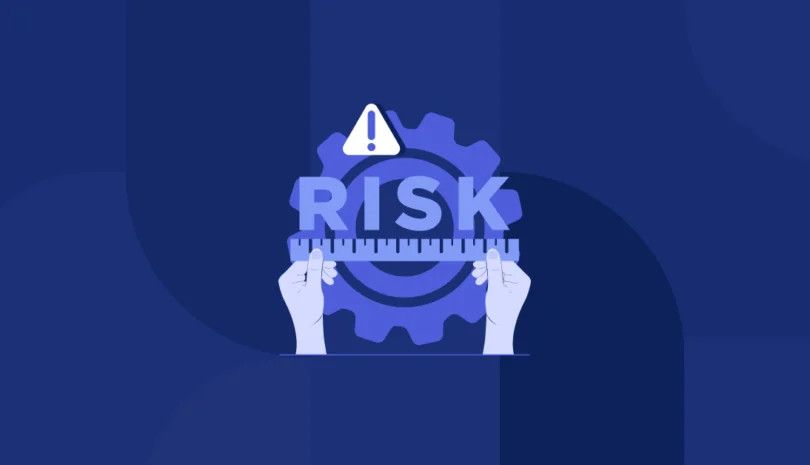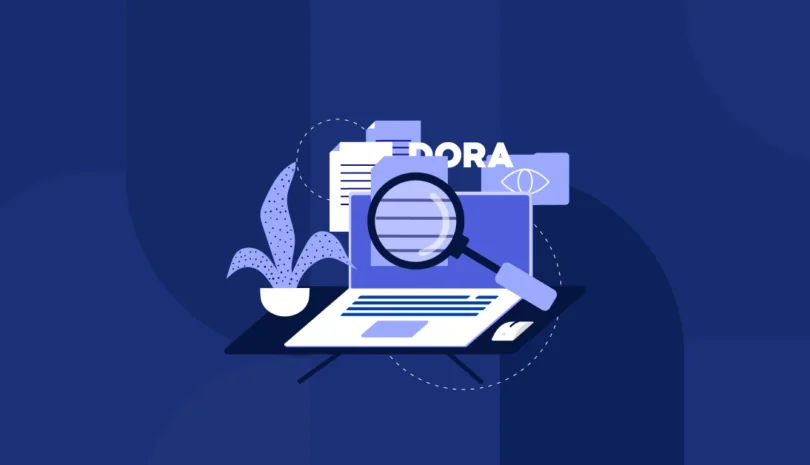The Digital Operational Resilience Act (DORA) is more than just another regulatory requirement, it represents a fundamental shift in how financial institutions in the EU must approach operational resilience. By mandating rigorous oversight of ICT risk, DORA is raising the bar for digital accountability across the financial sector and its third-party ecosystems.
With enforcement beginning in January 2025, organizations can no longer afford a reactive approach. Financial entities, including banks, insurers, asset managers, and critical third-party providers, must proactively prepare for compliance. But doing so isn’t just about checking boxes. It’s about embedding resilience into the DNA of your operations.
This blog offers a strategic, step-by-step guide to selecting the right DORA compliance solution. Whether you’re building from the ground up or optimizing existing frameworks, we’ll help you navigate the complexities so that you can make smart, future-proof decisions. From assessing gaps to evaluating technology partners, our goal is to equip you with the insight needed to lead compliance efforts with clarity and confidence.
Understanding DORA Requirements
At its core, the Digital Operational Resilience Act (DORA) aims to ensure that financial entities can withstand, respond to, and recover from ICT-related disruptions. To achieve this, DORA outlines five key pillars of compliance:
- ICT Risk Management: Firms must establish and maintain frameworks for identifying, managing, and mitigating ICT risks across the organization.
- Incident Reporting: Significant ICT-related incidents must be reported to regulators promptly, following a standardized process to ensure transparency and coordination.
- Digital Operational Resilience Testing: Regular, threat-led penetration tests are required to validate the effectiveness of an entity’s digital defenses and response capabilities.
- Third-Party Risk Management: Organizations must ensure that any ICT service providers, including cloud and software vendors, meet equivalent resilience and security standards.
- Information Sharing: Voluntary sharing of cyber threat intelligence among financial entities is encouraged to strengthen collective defense across the sector.
DORA comes into full effect on January 17, 2025. Failure to comply could result in significant financial penalties, supervisory actions, and reputational damage. With the clock ticking, understanding these requirements is the first step toward building a resilient, compliant future.
Common Types of DORA Solutions
As organizations prepare for DORA, the market has responded with a wide range of solutions, each designed to support different aspects of compliance. Choosing the right type depends on your existing capabilities, risk profile, and operational complexity.
- End-to-end DORA compliance platforms offer a centralized approach, covering all five pillars, from ICT risk management to third-party oversight. These solutions are ideal for organizations looking to streamline efforts, ensure alignment across teams, and reduce the burden of managing multiple vendors.
- Specialized tools focus on individual compliance areas, such as incident reporting, resilience testing, or ICT risk mapping. These are best suited for companies that already have mature systems in place and want to fill specific gaps without overhauling their entire tech stack.
- Managed services and third-party risk platforms provide outsourced support or targeted automation, particularly for areas like third-party assessments, continuous monitoring, and regulatory reporting. These can be especially valuable for lean teams or firms with complex vendor ecosystems.
- A single-platform approach simplifies oversight and integration, while an integrated stack offers more flexibility and customization. The right choice depends on your organization’s structure, regulatory maturity, and the need for scalability as DORA enforcement evolves.
Key Features to Look For in a DORA Solution
Not all DORA solutions offer the depth and flexibility needed to support long-term digital resilience. A strong platform should go beyond checking boxes, it must provide comprehensive visibility into ICT and third-party risk, automate key processes like incident reporting and testing, and align closely with EU regulatory requirements. Seamless integration with your existing systems, such as GRC, procurement, and ERP platforms, is also essential. Ultimately, the right solution will enable continuous compliance, reduce operational friction, and enhance your organization’s ability to adapt to evolving threats. Below, we outline the seven core features to prioritize during your evaluation.
Comprehensive Risk Monitoring and Assessment
Effective DORA compliance starts with understanding and monitoring your third-party landscape. Look for solutions that continuously track vendor risk using real-time threat intelligence and dynamic scoring models. These tools should go beyond surface-level assessments, identifying security gaps, outdated controls, and compliance blind spots across all third-party relationships, including non-critical vendors. A strong solution enables proactive risk mitigation and gives stakeholders a clear, up-to-date view of where vulnerabilities lie, helping to prevent issues before they escalate into reportable incidents.
Automated Incident Detection and Reporting Capabilities
Timely incident detection and regulatory reporting are critical under DORA. Your solution should automatically flag anomalies, breaches, or suspicious behavior involving third-party systems, and trigger real-time alerts for rapid response. Additionally, it should streamline compliance by generating standardized, regulator-ready reports aligned with frameworks like DORA, GDPR, and NIS2. Automation reduces human error, accelerates reporting timelines, and ensures that you stay on the right side of regulatory requirements even under pressure.
DORA Solutions for Third-Party and Supply Chain Risk Management
DORA mandates oversight of not only direct vendors but the entire ICT supply chain. The right solution will give you visibility into both first-tier providers and their subcontractors, enabling you to assess risk holistically. Look for capabilities like dependency mapping and cascading impact analysis tools that help you understand how one weak link can affect your entire ecosystem. This broader perspective is key to maintaining operational resilience and making informed vendor decisions.
Audit Trails and Documentation Management
Regulators expect clear, auditable records of how decisions are made. Choose a DORA solution that captures time-stamped logs of every action, from risk assessments and approvals to incident responses. Equally important is a centralized repository where vendor contracts, due diligence documents, communications, and risk reports are securely stored and easily searchable. Strong documentation ensures transparency, speeds up audits and proves due diligence in the face of regulatory scrutiny.
DORA Solution Interoperability with Existing Systems
Your DORA solution shouldn’t operate in a silo. The best platforms integrate effortlessly with your existing tools, such as procurement systems, ERP platforms, GRC tools, and ticketing solutions like ServiceNow or SAP. Interoperability allows for automated data sharing, consistent workflows, and a unified risk posture across departments. This helps break down silos, increase operational efficiency, and reduce the complexity of compliance across functions.
Scalability and EU Regulatory Alignment
A future-ready DORA solution should scale with your organization as it grows and adapts to regulatory change. Whether you’re expanding across regions, departments, or new third-party relationships, your system must remain agile without requiring reconfiguration. It should also map controls to current and emerging EU regulations, like DORA, GDPR, and NIS2, enabling cross-framework compliance and reducing the time and cost of maintaining alignment with complex regulatory requirements.
User Access Controls and Cybersecurity Features
Security should be built in, not bolted on. Look for DORA solutions that enforce strict role-based access controls, ensuring that only authorized personnel can view or modify sensitive information. Essential cybersecurity features, such as data encryption, multi-factor authentication (MFA), and secure communications, protect both your organization and your third-party ecosystem. These controls are foundational to compliance and help build trust across internal teams and external partners.
Conducting a Risk-Based Gap Assessment
Before selecting a DORA solution, organizations must first understand where they stand today. A risk-based gap assessment allows you to evaluate your current capabilities against DORA’s five pillars and prioritize efforts based on actual exposure. Start by mapping each DORA requirement, such as incident reporting, third-party oversight, and resilience testing, against your existing tools, processes, and teams. This will help you identify redundancies, missing capabilities, and areas that require immediate attention.
From there, focus on the most critical risk areas. For many organizations, these include visibility into the full supply chain, continuous risk monitoring, and the ability to produce auditable documentation. Tools that may have worked for internal compliance (e.g., GDPR) may fall short under DORA’s operational resilience lens.
By assessing gaps through the lens of business impact and regulatory urgency, you can build a roadmap for remediation, whether that means deploying new platforms, integrating existing systems, or bringing in managed services. The goal is to align risk with resource allocation, ensuring that your DORA strategy is both effective and efficient. This structured approach not only accelerates compliance but strengthens your broader digital resilience posture.
DORA Solutions for Your Organization
Choosing the right DORA solution isn’t just about checking a compliance box, it’s a strategic investment in your organization’s long-term operational resilience. The tools and frameworks you adopt today will shape how effectively you can respond to disruption, manage third-party risks, and maintain trust with regulators, partners, and customers.
As the January 2025 enforcement deadline has already passed, the focus must now shift from last-minute compliance to optimizing for sustainability and performance. Regulators are watching closely, and gaps in implementation could lead to fines, operational setbacks, or reputational harm.
Now is the time to refine your strategy: assess what’s working, identify where gaps remain, and invest in tools that not only align with DORA but also elevate your broader digital resilience. Taking a proactive stance today means fewer risks and fewer surprises tomorrow.
By adopting Panorays, financial institutions can streamline their compliance efforts, enhance their operational resilience, and ultimately position themselves as trusted leaders in the financial sector. Read this guide on DORA compliance and third-party risk management or reach out to us to help you get started toward becoming DORA compliant.
Ready to get DORA compliance under control? Contact Panorays to learn more.
DORA Solution FAQs
-
Any financial entity operating in the EU, such as banks, insurers, investment firms, and ICT service providers, must comply with the Digital Operational Resilience Act (DORA). Even organizations based outside the EU may fall under DORA’s scope if they provide services to EU financial institutions. This is particularly relevant in the context of third-party risk, where non-EU vendors can indirectly impact the resilience of EU-based firms.
-
A robust DORA solution empowers organizations to proactively identify, assess, and monitor risks across their vendor ecosystem. It supports continuous mapping of digital dependencies, evaluates vendor resilience, and enforces contractual safeguards around incident reporting, risk testing, and recovery. Unlike point-in-time assessments, effective solutions offer real-time visibility into the digital supply chain, helping institutions comply with ongoing oversight requirements.
-
While some platforms aim to address all five DORA pillars—ICT risk management, incident reporting, testing, third-party oversight, and information sharing—true compliance often requires integration with existing systems (ERP, GRC, procurement) and alignment with internal workflows. The most successful strategies combine centralized visibility with modular interoperability.
-
DORA builds on widely accepted standards such as NIST and ISO 27001 but introduces legal enforceability. It places stronger emphasis on incident reporting, vendor oversight, and continuity planning, transforming best practices into mandatory requirements for digital resilience.



